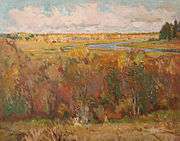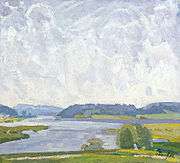Academicheskaya Dacha
Academicheskaya Dacha (Russian: Академическая Дача) — the oldest and well-known creative base of the Union of Artists of the Russian Federation. Located in the Tver Province near the Vyshny Volochyok town at the eight kilometers from the railway station in a picturesque location on the banks of Msta River and Mstino lake. In a broader sense the Academicheskaya Dacha (or «Academichka») call it the neighborhood with the villages of Bolshoy Gorodok, Maliy Gorodok, Kisharino, Terpigorevo, Valentinovka, Podol, and others, in many populated by Russian artists in the mid-second half of the 20th century.
History
Opened on July 22, 1884 as a place of summer practice for poor students of the Imperial Academy of Arts. A plot of land with the park, house and buildings had been taken on lease the Academy of Arts in Ministry of Railways. It was originally named as Vladimir and Maria shelter in honor of President of the Imperial Academy of Arts Grand Duke Vladimir and his wife Grand Duchess Maria Pavlovna and the Empress Maria Alexandrovna. The exceptional role in «Academicheskaya Dacha» organization and accomplishment иу, "Academic cottages" belonged to her guardian Kokorev Vasili Alexandrovich (1817-1889), a major industrialist, salter, the owner of one of the largest collections of Russian and Western European art.
Before the October revolution 1917, on the «Academicheskaya Dacha» worked many famous Russian artists, among them Ilya Repin, Nikolay Bogdanov-Belsky, Pavel Chistyakov, Arkhip Kuindzhi, Isaac Levitan, Andrei Ryabushkin, Nicholas Roerich, Valentin Serov, and many others. After 1917 the house was given to the children, there was open summer camp. Its functioning in the old as possible to restore only in 1948. Since that time the «Academicheskaya Dacha» has become one of the recognized centers of creative life in the Soviet Union and Russia. In those years here worked such known Russian painters as Aleksei Gritsai, Vecheslav Zagonek, Dmitry Maevsky, Maya Kopitseva, Fyodor Reshetnikov, Nikolai Pozdneev, Nikolai Timkov, and many others. It is no accident, noting the role of the Academicheskaya Dacha in preserving and promoting the traditions of Russian realistic Art, it is called the «Russian Barbizon». The best art works of landscape and genre painting, exhibited in Art Shows of 1960-1980's, was created primarily on the «Academicheskaya Dacha» and its surroundings. Later in the years 1970-1980's to meet the needs of artists here were built modern workshops and office buildings that have been providing year-round use of the «Academicheskaya Dacha» for employment creation.
In 1964, the Academicheskaya Dacha was named after the famous Russian painter Ilya Repin. In 1974, near the main pavilion was opened monument to Ilya Repin (sculptor Oleg Komov, architect Nikolai Komov), in honor of the 130th anniversary of the artist. In 2004, during the celebration of the 120th anniversary of the Academicheskaya Dacha, the plaque in memory of Vasili Kokorev was open at the main pavilion building.
Gallery
-

Река Мста Зима. Озеро Мстино. Вид на Желниху с "Дачи художников" Landyshev A.
-

Timkov N. Academicheskaya Dacha. 1972
-

Pozdneev N. In Summer at reading. 1959
-

Maevsky D. March Sun. 1977
-

Pozdneev N. Natasha in Baby-Carriage. 1960
-

Nevelshtein S. Before thunderstorm. 1948
-

Maevsky D. Spring in Podol village. 1973
-

Kopitseva M. At the Bath-house. 1954
-

Pozdneev N. Still life in Grass. 1964
-

Maevsky D. April. 1968
-

Maevsky D. Summer day in Podol village. 1970
-

Nevelshtein S. A Fall near Academic Dacha. 1946
«Academics»
Russian Artists who worked at the Academicheskaya Dacha and her surroundings since the end of the 19th century:
- Ilya Repin
- Nikolay Bogdanov-Belsky
- Isaak Brodsky
- Pavel Chistyakov
- Arkhip Kuindzhi
- Isaac Levitan
- Andrei Ryabushkin
- Nicholas Roerich
- Valentin Serov
- Sergey Gerasimov
- Aleksei Gritsai
- Maya Kopitseva
- Boris Lavrenko
- Dmitry Maevsky
- Samuil Nevelshtein
- Nikolai Pozdneev
- Nikolai Timkov
- Anatoli Vasiliev
- Boris Ugarov
References
See also
- List of Russian artists
- List of 20th-century Russian painters
- List of painters of Saint Petersburg Union of Artists
- List of the Russian Landscape painters
- Saint Petersburg Union of Artists
- Leningrad School of Painting
Bibliography
- Романычева И. Академическая дача. Л., Художник РСФСР, 1975.
- Sergei V. Ivanov. Unknown Socialist Realism. The Leningrad School. Saint Petersburg, NP-Print Edition, 2007. PP.22-24, 40-41, 93, 98-99, 117-118, 194, 202, 223, 248, 261, 312, 335, 364, 377, 388.
- Романычева И. Академическая дача. История и традиции. СПб., Петрополь, 2009.
- Академическая дача. Каталог выставки. СПб., 2009.
External links
- Bondareva N. The Academicheskaya Dacha. (Russian).


